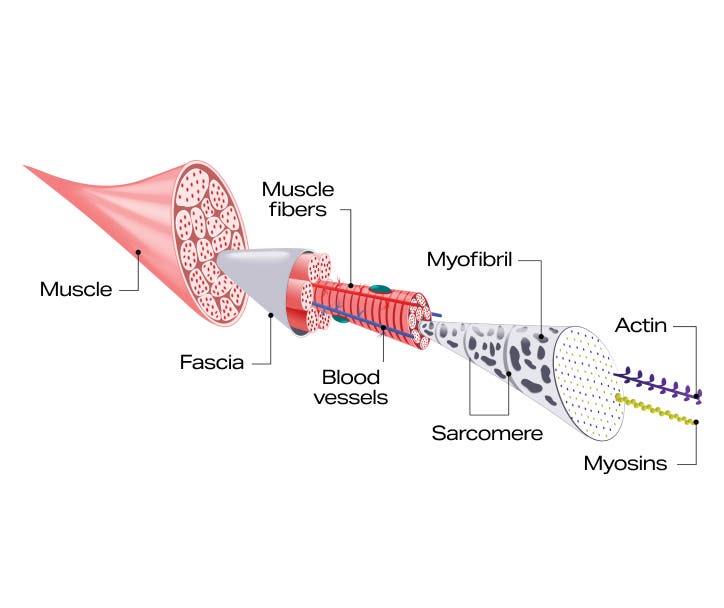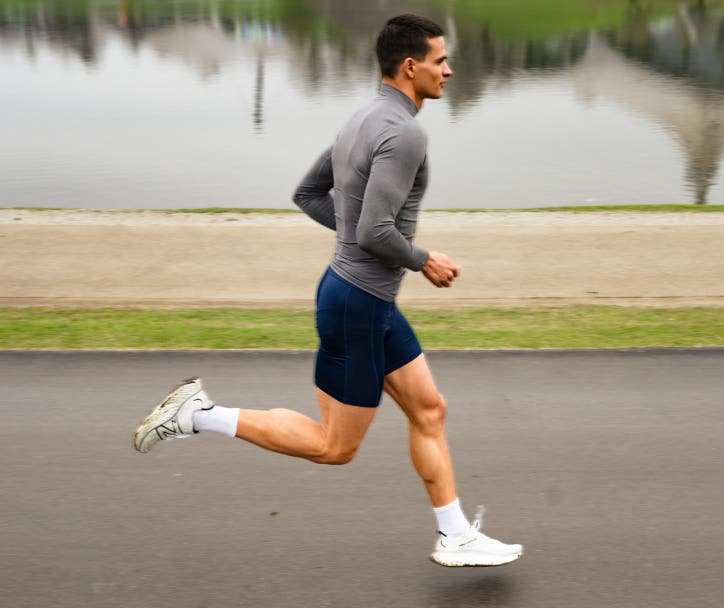Muscles, the unsung heroes of your body, play a vital role in your daily life. From the simplest tasks like reaching for a cup of coffee to more complex movements such as running a marathon.
Beyond their role in movement, muscles are integral to your overall health and well-being. And by understanding the science behind them, you can better appreciate the marvel of your body and optimize your workouts to enhance your quality of life.
The basic role of skeletal muscles
Skeletal muscles, connected to bones by tendons, control the voluntary movements of your body. They are the driving force behind your every move.
Besides movement, they also play a key role in maintaining posture, keeping you upright against the pull of gravity.1 A simple task like sitting or standing would be impossible without the support of skeletal muscles.
Anatomy of skeletal muscles
To understand how muscles work, it's essential to delve into their anatomy.
Skeletal muscles are composed of muscle fibers, which are long, cylindrical cells that contract to generate force. These fibers are organized into bundles called fascicles, which, in turn, make up the muscle itself.
At a microscopic level, muscle fibers contain myofibrils, which are composed of even smaller units called sarcomeres. Within sarcomeres, actin and myosin filaments slide past each other during contraction, generating force and causing muscle shortening.2

Muscle contraction and relaxation
Muscle contraction is a complex process that begins with electrical signals from the nervous system.
When you decide to move a muscle, your brain sends a signal through motor neurons to the muscle fibers, triggering the release of calcium ions within the muscle cells. These ions then bind to proteins within the sarcomeres, allowing actin and myosin filaments to interact and produce force.3 When the nervous system stimulation ceases, calcium ions are pumped back into storage, leading to muscle relaxation.
Types of muscle contractions
Muscle contractions come in three primary forms, each serving a different purpose:
- Concentric contractions: When the muscle shortens while generating force. In a bicep curl, for instance, the bicep muscle contracts concentrically to lift the weight.
- Eccentric contractions: Involve the muscle lengthening while under tension. In the lowering phase of a bicep curl, the bicep muscle contracts eccentrically to control the weight's descent.
- Isometric contractions: Occur when the muscle generates force without changing length. Holding a plank position or getting stuck in a deep squat are examples of isometric contractions, where the muscles work against resistance without movement.
Each type of contraction plays a unique role in movement and strength development, and incorporating all three into your workout routine can lead to well-rounded muscle development.

Muscle response to exercise
Different types of exercise elicit distinct responses from your muscles. Let’s look at how two of the most popular types of exercise can trigger your muscles to respond.
Resistance training
When you engage in resistance training, such as bodyweight exercises or lifting weights, your muscles experience micro-tears in the muscle fibers. These micro-tears occur as a result of the stress placed on the muscles during exercise.4
In response to these micro-tears, the body initiates a process called muscle protein synthesis, where new proteins are created to repair and rebuild the damaged muscle fibers. Over time, with consistent resistance training and adequate rest, these repaired muscle fibers increase in size and strength, leading to muscle hypertrophy.
Resistance training also boosts the production of hormones like testosterone and growth hormone, which further promote muscle growth and strength development. This adaptation involves not only an increase in muscle size (hypertrophy) but also improvements in muscle fiber recruitment and coordination, enhancing overall strength and power output.
Cardiovascular exercise
Unlike resistance training, cardiovascular exercise primarily focuses on the cardiovascular system, including the heart and blood vessels. Activities like running, swimming, or cycling increase heart rate and blood flow, improving cardiovascular endurance and efficiency. Additionally, these activities engage muscles throughout the body to support movement and maintain posture.
While cardiovascular exercise may not lead to significant muscle growth like resistance training, it still provides numerous benefits for muscle health. During cardiovascular exercise, muscles undergo repetitive contractions, which help maintain tone and flexibility.
Cardiovascular exercise also promotes the delivery of oxygen and nutrients to muscles, supporting their function and recovery. Regular cardio can also help prevent age-related muscle loss (sarcopenia) and enhance overall metabolic health.
By combining resistance training with cardio, you can create a powerful fitness routine that maximizes muscle growth and overall health.

Muscle adaptation and recovery
Following exercise, muscles undergo a process of adaptation and recovery. During this time, they repair damaged fibers and increase in size and strength to better handle future demands.
That's why regular R&R is so dang important! Rest and recovery are just as essential as exercise – read that again. By doing so, you’re enabling the body to restore energy and repair tissue damage. Without proper rest, muscles can become fatigued and injury-prone, stalling progress and performance.
And don’t forget the final piece of the puzzle – proper nutrition. Eating a well-balanced diet with sufficient protein intake provides the building blocks for muscle repair and growth. Pair that with proper hydration and micronutrients like vitamins and minerals to unlock optimal muscle function and recovery.5
Let’s recap
Understanding the science of muscle flexing empowers you to optimize your workouts and achieve your fitness goals more effectively.
These are five simple takeaways to implement into your routine:
- Diversify your workouts: Incorporate a variety of exercises, including both resistance training and cardiovascular activities, to stimulate muscle growth and cardiovascular health.
- Prioritize rest and recovery: Allow adequate time for muscles to recover between workouts to prevent overtraining and optimize growth.
- Fuel your body: Consume a balanced diet rich in protein, carbohydrates, healthy fats, vitamins, and minerals to support muscle repair and growth.
- Listen to your body: Pay attention to signs of fatigue or injury and adjust your workout intensity and frequency accordingly.
- Set realistic goals: Progress takes time, so be patient and consistent in your efforts, focusing on gradual improvements rather than rapid results.
Flexing your muscles is not just about showcasing strength; it's a testament to the incredible science behind human movement and health.
By understanding and applying this knowledge, you can unlock your full potential and embark on a journey toward greater strength, vitality, and well-being.
Sources
[1] Narici, M., et al. (2016). Skeletal Muscle Remodeling in Response to Altered Use. Journal of Muscle Research and Cell Motility, 37(4), 135-137. DOI: 10.1007/s10974-016-9440-7
[2] Standring, S. (Ed.). (2016). Gray's Anatomy: The Anatomical Basis of Clinical Practice (41st ed.). Elsevier Health Sciences. ISBN-13: 978-0702052309
[3] Huxley, A. F., & Niedergerke, R. (1954). Structural Changes in Muscle During Contraction; Interference Microscopy of Living Muscle Fibres. Nature, 173(4412), 971-973. DOI: 10.1038/173971a0
[4] Schoenfeld, B. J. (2010). The Mechanisms of Muscle Hypertrophy and Their Application to Resistance Training. Journal of Strength and Conditioning Research, 24(10), 2857-2872. DOI: 10.1519/JSC.0b013e3181e840f3
[5] Phillips, S. M., & Van Loon, L. J. (2011). Dietary Protein for Athletes: From Requirements to Optimum Adaptation. Journal of Sports Sciences, 29(Suppl 1), S29-S38. DOI: 10.1080/02640414.2011.619204